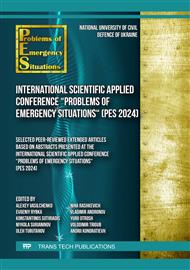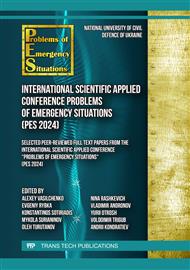[1]
Krot O.P. Energy efficiency of waste incineration on the recommendation of the EU Directive. «Scientific notes Taurida V.I. Vernadsky National University». Series: Technical sciences 29 (68) 3 р.2 (2018) 78–82.
DOI: 10.32838/2663-5941/2021.5/24
Google Scholar
[2]
Tsytlishvili К., Rashkevich N., Poltavska D. Research of Modern technologies of Wastewater Treatment of Food Products Combined with Ozonation and Hydrogen Peroxide. Key Engineering Materialsthis link is disabled 925 (2022) 169–178.
DOI: 10.4028/p-t5m3y6
Google Scholar
[3]
Myroshnychenko A., Loboichenko V., Divizinyuk M., Levterov A., Rashkevich N., Shevchenko O., Shevchenko R. Application of Up-to-Date Technologies for Monitoring the State of Surface Water in Populated Areas Affected by Hostilities. Bulletin of the georgian national academy of sciences 16 3 (2022) 50–59.
Google Scholar
[4]
Ji L., Lu S., Yang J., Du C., Chen Z., Buekens A., Yan J. Municipal solid waste incineration in China and the issue of acidification: A review. Waste Management & Research 34(4) (2016) 280–297.
DOI: 10.1177/0734242x16633776
Google Scholar
[5]
Xiaowen Su, Lin Zhang, Yuxin Xiao, Mingming Sun, Xue Gao, Jixin Su. Evaluation of a flue gas cleaning system of a circulating fluidized bed incineration power plant by the analysis of pollutant emissions. Powder Technology 286 (2015) 9–15.
DOI: 10.1016/j.powtec.2015.07.038
Google Scholar
[6]
Thabit Q, Nassour A, Nelles M. Flue Gas Composition and Treatment Potential of a Waste Incineration Plant. Applied Sciences 12(10) (2022) 5236.
DOI: 10.3390/app12105236
Google Scholar
[7]
Alyssa R. Pfadt-Trilling, Timothy A. Volk, and Marie-Odile P. Fortier. Climate Change Impacts of Electricity Generated at a Waste-to-Energy Facility. Environmental Science & Technology 55 (3) (2021) 1436–1445.
DOI: 10.1021/acs.est.0c03477
Google Scholar
[8]
Jeswani H.K., Azapagic A. Assessing the environmental sustainability of energy recovery from municipal solid waste in the UK. Waste Management 50 (2016) 346–363.
DOI: 10.1016/j.wasman.2016.02.010
Google Scholar
[9]
Chen YC, Liu HM. Evaluation of greenhouse gas emissions and the feed-in tariff system of waste-to-energy facilities using a system dynamics model. Science of The Total Environment 792 (2021) 148445.
DOI: 10.1016/j.scitotenv.2021.148445
Google Scholar
[10]
Kaplan P.O., Decarolis J., Thorneloe S. Is it better to burn or bury waste for clean electricity generation? Environ Sci Technol. 43(6) (2009) 1711–1717.
DOI: 10.1021/es802395e
Google Scholar
[11]
Mukherjeea A., Debnathb B., Ghoshc S.K. A Review on Technologies of Removal of Dioxins and Furans from Incinerator Flue Gas. Procedia Environmental Sciences 35 (2016) 528–540.
DOI: 10.1016/j.proenv.2016.07.037
Google Scholar
[12]
Rashkevich N., Shevchenko R., Khmyrov I., Soshinskiy A. Investigation of the Influence of the Physical Properties of Landfill Soils on the Stability of Slopes in the Context of Solving Civil Security Problems. Materials Science Forum 1038 (2021) 407–416.
DOI: 10.4028/www.scientific.net/msf.1038.407
Google Scholar
[13]
Ghouleh Z., Shao Y. Turning municipal solid waste incineration into a cleaner cement production. Journal of Cleaner Production 195 (2018) 268–27.
DOI: 10.1016/j.jclepro.2018.05.209
Google Scholar
[14]
Xiao H., Ru Y., Peng Z., Yan D., Li L., Karstensen K.H., Wang N., Huang Q. Destruction and formation of polychlorinated dibenzo-p-dioxins and dibenzofurans during pretreatment and co-processing of municipal solid waste incineration fly ash in a cement kiln Chemosphere 210 (2018) 779–788.
DOI: 10.1016/j.chemosphere.2018.07.058
Google Scholar
[15]
Czerwińska J., Wielgosiński G. Functioning of the flue gas treatment system in Polish municipal waste incineration plants. Scientific Review Engineering and Environmental Sciences (SREES) 29(1) (2020) 108–119.
DOI: 10.22630/pniks.2020.29.1.10
Google Scholar
[16]
Wielgosiński G., Namiecińska O., Czerwińska J. Environmental impact of emissions from incineration plants in comparison to typical heating systems. E3S Web of Conferences X-th Scientific Conference Air Protection in Theory and Practice 28 (2018) 01038.
DOI: 10.1051/e3sconf/20182801038
Google Scholar
[17]
Pozzo A. Dal, Guglielmi D., Antonioni G., Tugnoli A. Sustainability analysis of dry treatment technologies for acid gas removal in waste-to-energy plants. Journal of Cleaner Production 162 (2017) 1061–1074.
DOI: 10.1016/j.jclepro.2017.05.203
Google Scholar
[18]
Cheng-Yuan Chang, Chu-Fang Wang, D T Mui, Man-Ting Cheng, Hung-Lung Chiang. Characteristics of elements in waste ashes from a solid waste incinerator in Taiwan. Journal of Hazardous Materials. 165 1–3 (2009) 766–773.
DOI: 10.1016/j.jhazmat.2008.10.059
Google Scholar
[19]
Hagenmaier H., Kraft M., Brunner H., Haag R. Catalytic effects of fly ash from waste incineration facilities on the formation and decomposition of polychlorinated dibenzo-p-dioxins and polychlorinated dibenzofurans. Environmental Science & Technology 21 (1987) 1080–1084.
DOI: 10.1021/es00164a006
Google Scholar
[20]
Silva R.V., J. de Brito, Lynn C.J., Dhir R.K. Environmental impacts of the use of bottom ashes from municipal solid waste incineration: A review Resources. Conservation and Recycling 140 (2019) 23-35.
DOI: 10.1016/j.resconrec.2018.09.011
Google Scholar
[21]
Jiang Y., Yang L., Han D., Yang Z., Su C., Lin R., Wang X., Zhu X. The enhanced Pb resistance of CeO2/TiO2 catalyst for selective catalytic reduction of NO with NH3 by the modification with W. Molecular Catalysis 514 (2021) 111839.
DOI: 10.1016/j.mcat.2021.111839
Google Scholar
[22]
Chul-Hoon Cho, Son-Ki Ihm. Development of New Vanadium-Based Oxide Catalysts for Decomposition of Chlorinated Aromatic Pollutants. Environmental Science & Technology 36 (2002) 1600–1606.
DOI: 10.1021/es015687h
Google Scholar
[23]
Rotshtein A.P., Shtovba S.D. Fuzzy multi-criteria analysis of options using paired comparisons. Izvestiya Academy of Sciences. Theory and Control Systems 3 (2001) 150–154.
Google Scholar



